Complete Solutions to Solved Examples of chapter DUAL NATURE OF RADIATION AND MATTER of Class 12 book with complete answers and questions
| Class 12 | PHYSICS |
| Chapter | DUAL NATURE OF RADIATION AND MATTER |
| PRADEEP | Solved Examples |
| Number Of Questions | 100 |
| Academic Year | 2023-24 |
The work function of cesium is 2.14 eV. Find (a) the threshold frequency for cesium, and (b) the wavelength of the incident light if the photo current is brought to zero by a stopping potential 0.60 V. Given `h=6.63xx10^(-34)Js`.
View SolutionUsing the graph shown in fig for stopping potential `v_s` the incident frequency of photons, calculate Planck's constant.

View SolutionThe momentum of photon of electromagnetic radiation is `3.3xx10^(-29)kgms^-1`. What is the frequency and wavelength of the waves associated with it ? `h=6.6xx10^(-34)Js`.
View SolutionFind the number of emitted per minute by a 25W source of monochromatic light of wavelength 5000Å. Use `h=6.63xx10^(-34)Js`.
View SolutionWhat is the de-Broglie wavelength associated with (a) an electron moving with speed of `5.4xx10^6ms^-1`, and (b) a ball of mass 150g travelling at `30.0ms^-1`? `h=6.63xx10^(-34)Js`, mass of electron `=9.11xx10^(-31)kg`.
View SolutionThe equivalent wavelength of a moving electron has the same value as that of a photon having an energy of `6xx10^(-17)J`. Calculate the momentum of the electron.
View SolutionThrough what potential difference should an electron be accelerated so that its de-Broglie wavelength becomes 0.4Å?
View SolutionFind the de-Broglie wavelength of an electron in a metal at `127^@C`. Given, mass of electron `=9.11xx10^(-31)kg`, Boltsmann constant `=1.38xx10^(-23)"J mole"^-1K^-1` , Plank constant `=6.63xx10^(-34)Js`.
View SolutionThe work function `(phi_0)`, of a metal X, equals `3xx10^(-19)J`. Calculate the number (N) of photons, of light of wavelength 26.52nm, whose total energy equal W. Plank's constant `=6.63xx10^(-34)Js.`
View SolutionThe work function for the following metals is given Na: 2.75 eV, K:2.30 eV , Mo: 4.17 eV , Ni: 515 eV.
Which of these metals will not give photoelectric emission for a radiation of wavelength 3300 A from a `He-Cd` laser placed 1m away from the photocell? What happens if the laser is brought nearer and placed 50 cm away?
View SolutionBy how which would the stopping potential for a given photosensitive surface go up if the frequency of the incident radiations were to be increased from `4xx10^(15)Hz` to `8xx10^(15)Hz`? Given, `h=6.6xx10^(-34)Js`, `e=1.6xx10^(-19)C and c=3xx10^8ms^-1`.
View SolutionWork function of sodium is 2.3 eV. Does sodium show photoelectric emission for orange light `(lambda=6800Å)`?
Given `h=6.63xx10^(-34)Js`
View SolutionA metal has a work function of 2.0 eV and is illuminated by monochromatic light of wavelength 500nm. Calculate (a) the threshold wavelength (b) the maximum energy of photoelectrons (c) the stopping potential. [use h=`6.63xx10^(-34) J, c=3xx10^8ms^-1`]
View SolutionThe work fuction of caseium is 2.14 eV. Find (a) the threshold frequency for caesium and (b) the wavelength of the incident light if the photocurrent is brought to zero by a stopping potential of 0.60V. Given `h=6.63xx10^(-34)Js.`
View SolutionThe work function for a metal is 1.8eV. Light of 5000Å is incident on it. Calculate (a) threshold frequency and threshold wavelength, (b) maximum kinetic energy of the emitted electrons, (c) maximum velocity of the emitted electrons, (d) if the intensity of the incident light be doubled, then what will be the maximum kinetic energy of the emitted electrons? given, `h=6.63xx10^(-34)Js, m_e=9xx10^(-31)kg, c=3xx10^8ms^-1.`
View SolutionPhotoelectrons are emitted from a metal surface when ultraviolet light of wavelength 300nm is incident on it. The minimum negative potential required on it. The minimum negative potential required to stop the emission of electrons is 0.54V. Calculate:
(i) the energy of the incident photons
(ii) the maximum kinetic energy of the photoelectrons emitted
(iii) the work function of the metal Express all answer in eV. `(use h=6.63xx10^(-34)Js)`
View SolutionBy how which would the stopping potential for a given photosensitive surface go up if the frequency of the incident radiations were to be increased from `6xx10^(15)Hz` to `16xx10^(15)Hz`? Given, `h=6.6xx10^(-34)Js`, `e=1.6xx10^(-19)C and c=3xx10^8ms^-1`.
View SolutionLight of wavelength 5000Å falls on a metal surface of work function 1.9eV. Find (i) the energy of photons in eV (ii) the kinetic energy of photoelectrons and (iii) the stopping potential. Use `h=6.63xx10^(-34)Js`,
`c=3xx10^8ms^-1 , e=1.6xx10^-9C.`
View Solution(a) The work function for the surface of aluminum is 4.2eV. How much potential difference will be required to stop the emission of maximum energy electrons emitted by light of 2000Å wavelength?
(b) What will be the wavelength of that incident light for which stopping potential will be zero ? `h=6.6xx10^(-34) Js, c=3xx10^8ms^-1`.
View Solution(a) The work function for the surface of aluminium is 4.2eV. Find potential difference will be required to stop the emission of maximum kinetic energy photoelectrons emitted by light of 1800Å wavelenght?
(b) Determine the wavelength of that incident light for which stopping potential will be zero? `(h=6.6xx10^(-34))`
View SolutionIn an experiment on photoelectic effect, the graph between maximum kinetic energy `(K_(max))` and frequency of emitted photoelectron from metal surface is found to be a straight line as shown in fig. Calculate
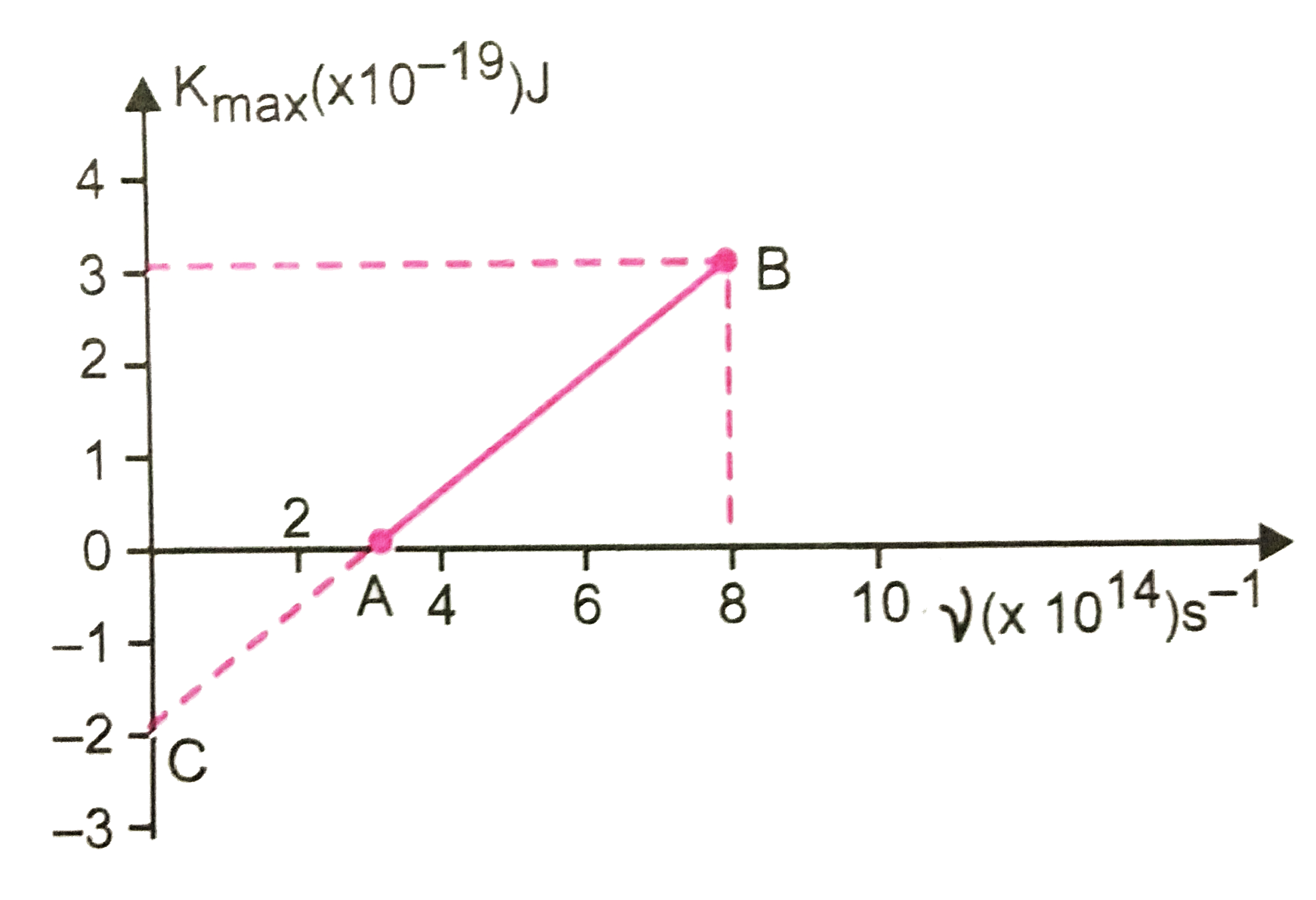
(a) thereshold frequency.
(b) work function of metal in electron volt.
(c) Planck's constant and
maximum kinetic energy of the emitted electron by light of frequency `v=8xx10^(14)s^-1`.
View SolutionWhen a piece of metal is illuminated by monochromatic light of wavelength `lambda` then the stopping potential for photoelectric current is 2.5 `V_0`. When the same surface is illuminated by light of wavelength 1.5 `lambda`, then the stopping potential becomes `V_0`. Find the value of threshold wavelength for photoelctric emission.
View SolutionA monochromatic source of light operating at 500W emits `6xx10^(20)` photon per second. Find the wavelength of the light used. Use `h=6.6xx10^(-34)Js , C=3xx10^8m//s`
View SolutionMonochromatic light of frequency `6.0xx10^(14)Hz` is produced by a laser. The power emitted is `2.0xx10^-3W`, (a) What is the energy of a photon in the light beam? (b) How many photons per second, on the average, are emitted by the source? Given `h=6.63xx10^(-34) Js`
View SolutionA monochromatic source emitting light of wavelength, 600nm, has a power output of 66W. Caculate the number of photons emitted by this source in 2minuts. Use `h=6.6xx10(-34)Js`.
View SolutionHow many photons are received on earth per `cm^-2` per hour if the energy from the sun reaching on the earth is at the rate of `2cal cm^(-2) min^(-1)` and average wavelength of solar light be taken as 5500Å. Use `h=6.6xx10^(-34)J , c=3xx10^8ms^(-1)` and `1cal =4,2J`
View SolutionIf 10% of the energy supplied to an incandescent light bulb is radiated as visible light, how many visible light photons are emitted by 200watt bulb? Assume wavelength of all visible photons to be 5000Å. Given `h=6.6xx10^(-34)Js`.
View SolutionThe wavelength of light in the visible region is about 390nm for violet colour, about 550nm (average wavelength) for yellow green colour and about 760nm for red colour. What are the energies of photon in eV at the (i) violet end (ii) average wavelength yellow-green colour and (iii) red end of the visible spectrum? `("Take " h=6.63xx10^(-34)Js and 1eV=1.6xx10^(-19)Js)`
View SolutionThe kinetic energy of the electron orbiting in the first excited state of hydrogen atom is 3.4 eV. Determine the de- broglie wavelength associated with it.
Mass of electron=`9.1xx10^(-31)kg`,
Planck's constant=`6.63xx10^(-34)Js`.
View SolutionThe wavelength `lambda` of a photon and the de-Broglie wavelength of an electron have the same value. Show that the energy of the photon is `(2 lambda mc)/h` times the kinetic energy of the electron, Where m,c and h have their usual meanings.
View SolutionThe equivalent wavelength of a moving electron has the same value as that of a photon having an energy of `6xx10^(-17)J`. Calculate the momentum of the electron.
View SolutionAn electron, an `alpha`-particle, and a photon have the same kinetic energy. Which of these particles has the shortest, de -broglie wavelenght?
View SolutionA particle is moving three times as fast as an electron. The ratio of the de- Broglie wavelength of the particle to that of the electron is `1.813xx10^-4`. Calculate the particle's mass and identity the particle. Mass of electron `=9.11xx10^(-31)kg`.
View SolutionWhat is the de-Broglie wavelength associated with an electron moving with an electron, accelerated through a potential difference of 100 volt?
View SolutionFind the de-Broglie wavelength (inÅ) associated with an electron moving with a velocity 0.6c, where `c=3xx10^8 m//s` and rest mass of electron `=9.1xx10^(-31)kg, h=6.63xx10^(-34)Js`.
View SolutionFind the de Broglie wavlength of a neutron at `127^circ`C Given that Boltzmann's constant `k=1.38xx10^(-23)J` `"molecule"^-1` `K^-1`. Planck's constant `=6.625xx10^(-34)Js`, mass of neutron `=1.66xx10^(-27)kg`.
View SolutionFor what kinetic energy of a proton, will the associated de-Broglie wavelength be 16.5nm? Mass of proton `=1.675xx10^(-27)kg , h=6.63xx10^(-34)Js`
View SolutionWhat is the de-Broglie wavelength of nitrogen molecule in air at 300K ? Assume that the molecule is moving with the root mean square speed fo molecules at this temperature. (Atomic mass of nitrogen `=14.0076U`) Plank's constant=`6.63xx10^(-34)Js` , Boltzmann constant `=1.38xx10^(-23)JK^(-1)`
View SolutionX-rays of wavelength 0.82Å fall on a metal plate. Find the wavelength associated with photoelectron emitted. Neglect work function of the metal.
Given `c=3xx10^8 m//s h=6.63xx10^(-34)Js.`
View SolutionFind the typical de-Broglie wavelength associated with a H-atom in helium gas at room temperature `(27^(@)C)` and 1atm pressure, and compare it with the mean separation between two atom under these conditions.
View Solutiona. A stopping potential of `0.82V` is required to stop the emission of photoelectrons from the surface of a metal by light of eavelength `4000 A`. For light of wavelength `3000 A`, the stopping potential is `1.85V`. Find the value of Planck's constant. [1 electrons volt (eV)`=1.6xx10^(-19)J]`
b. At stopping potential, if the wavelength of the incident light is kept fixed at `4000 A`, but the intensity of light increases two times, will photoelectric current be botained ? Give reasons for your answer.
View SolutionLight of wavelength 4000Å is incident on barium. Photoelectrons emitted describe a circle of radius 50 cm by a magnetic field of flux density `5.26xx10^-6 tesla`. What is the work of barium in eV? Given `h=6.6xx10^(-34)Js , e=1.6xx10^(-19)C, m_e=9.1xx10^(-31)kg.`
View SolutionCalculate the strength of the transverse magnetic field required to bend all photoelectorns within a circle of radius 50 cm, when light of wavelength 4000Å is incident on a barium emitter. Work function of barium is 2.5eV. Given, `m_e=9.1xx10^(-31)kg, e=1.6xx10^(-19)C, h=6.6xx10^(-34)Js.`
View SolutionThe extent of localization of a particle is determined roughly by its de Broglie wave. If an electron is localized within the nucleus (of size about `10^(14)`m) of an atom, what is its energy? Compare this energy with the typical binding energies (of the order of a few MeV) in a nucleus and hence argue why electrons cannot reside in a nucleus.
View SolutionRadiations of frequency `10^(15)Hz` is incident on three photosenstive surfaces. A,B and C. Following observations are recorded,
(a) Surface A. No photoemission occurs.
(b) Surface B. Photoemission occurs but the photoelectrons have zero kinetic energy.
(c) Surface C. Photoemission occurs and photoelectrons have some KE.
Based on Einstein's photoelectric equation, expalain the three observations.
View SolutionIt is easier to remove an electron from sodium then from copper. Which metal has higher value of threshold frequency?
View SolutionBlue light can eject electrons from a photosenstive surface while orange light can not. Will violet and red light eject electrons from the same surfac?
View SolutionIf the intensity of light falling on the emitting substance of a photoelectric cell be increased then what will be the effect on (i) current flowing from the cell, (ii) potential difference required to stop the current completely?
View SolutionWhen a metal surface is exposed with a monochromatic light, then all the photoelectrons are not emitted from the metal surface with the same kintetic energy. Why?
View SolutionFor three different materials, the variation of the stopping potential `V_0` and the wavelength `lambda` of the incident light is shown by curves a,b and c in fig. which material has maximum work function and which one has least work function ?
View SolutionDraw a graph showing the variation of stopping potential with frequency of the incident radiation. What does the slope of the line with frequency axis indicate? What information can be obtained from the values of intercept on the potential axis?
View SolutionFig. shows the variation of stopping potential `V_0` with the frequency v of the incident radiation for two photosensitive metal P and Q:
(i) Explain which metal has smaller threshold wavelength
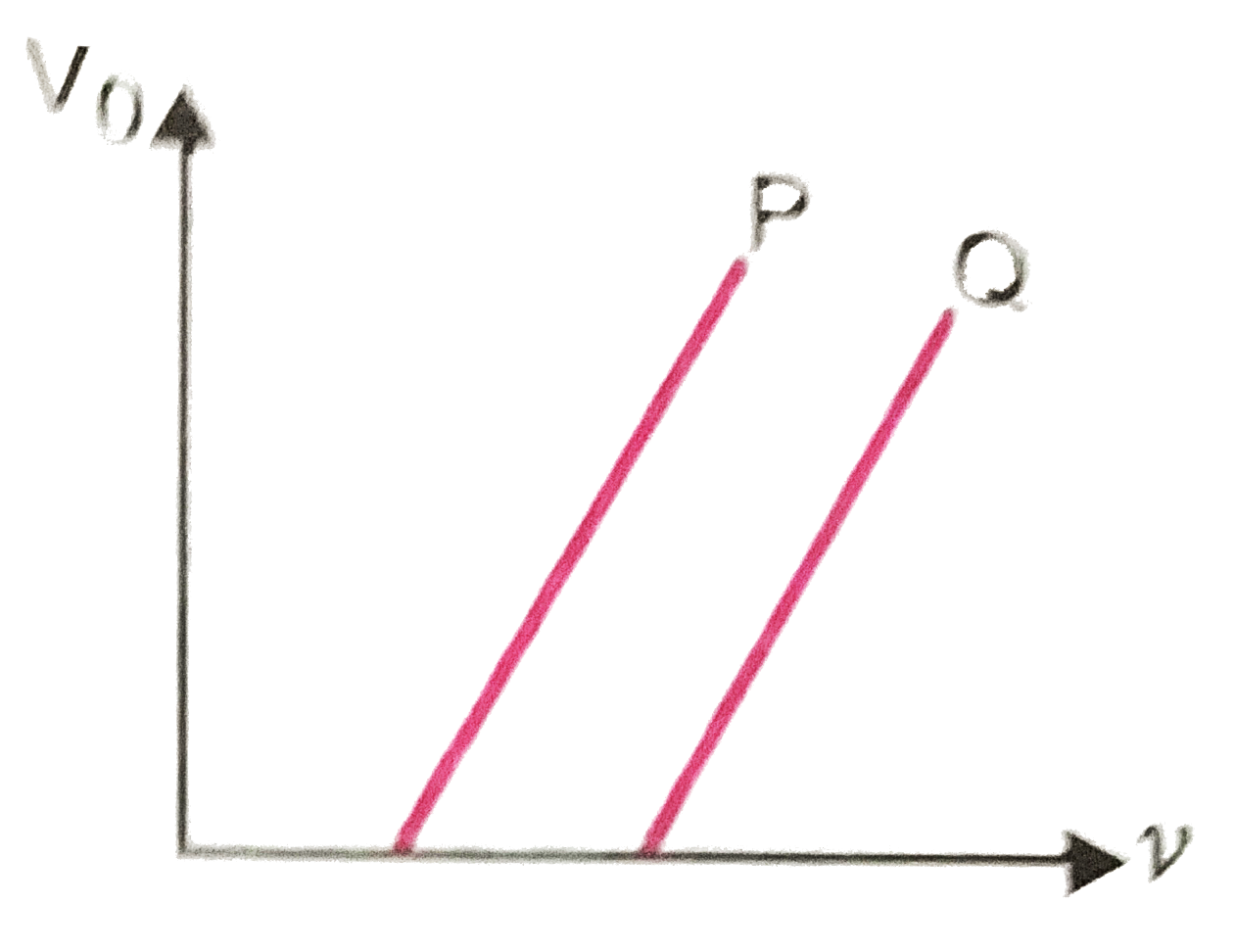
(ii) Explain, giving reason, which metal emits photoelectrons having smaller kinetic energy, for the same wavelength of incident radiation.
(iii) If the distance between the light source and metal P is doubled, how will the stopping potential change.
View SolutionIn the study of a photoelectric effect the graph between the stopping potential V and frequency v of the incident radiation on two different metals P and Q is shown in fig.
(i) which one of two metals have higher threshold frequency
(ii) Determine the work function of the metal which has greater value
(iii) Find the maximum kinetic energy of electron emitted by light of frequency `8xx10^(14) Hz` for this metal.
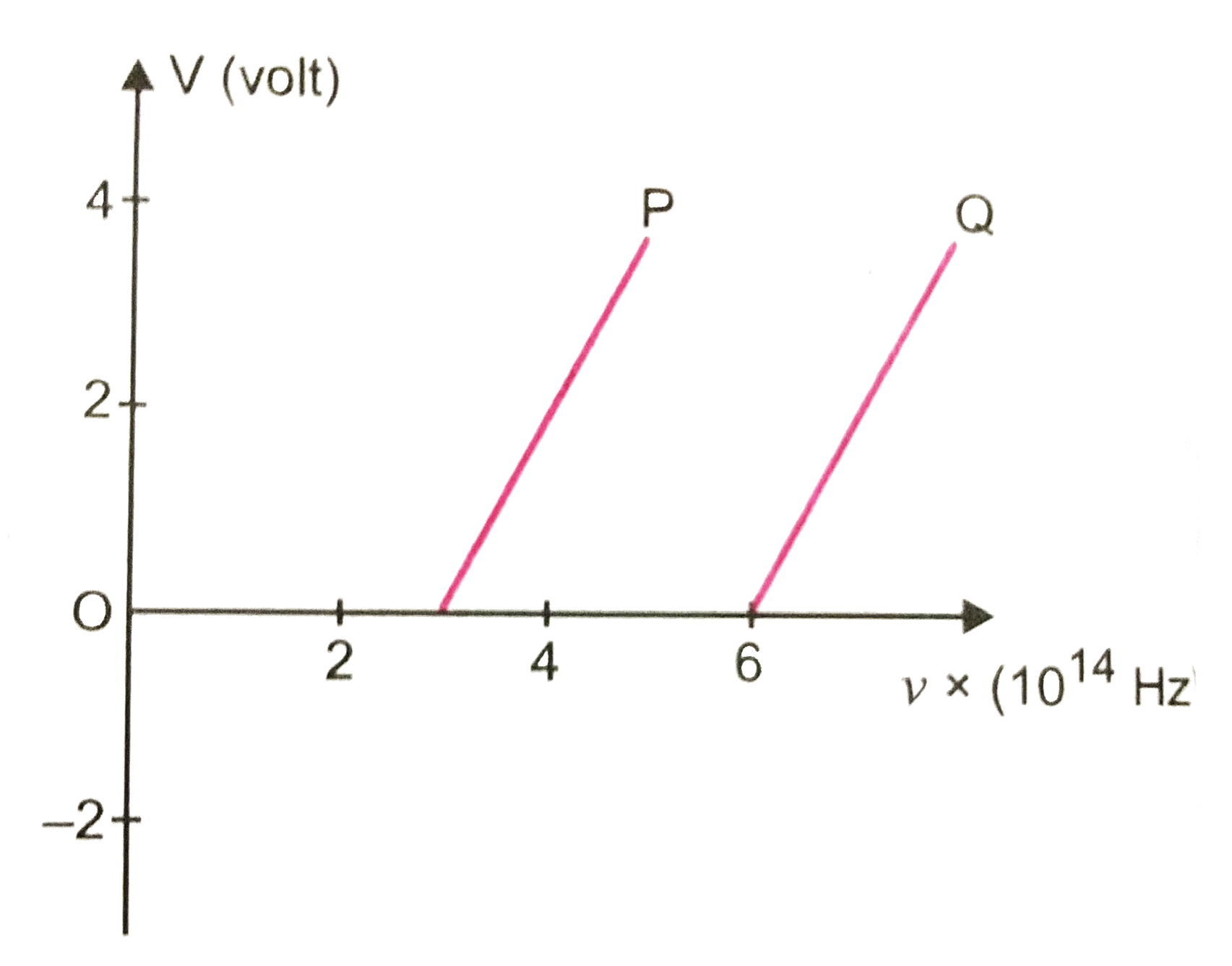
View Solutionfig. shows variation of stopping potential `(V_0)` with frequency (v) for two photosenstive matrials `M_1 and M_2`.
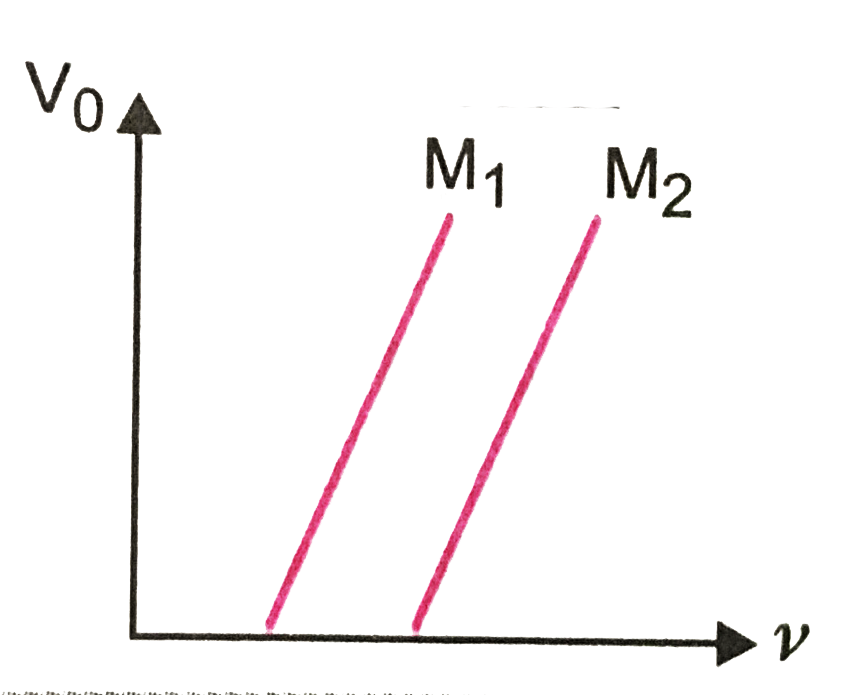
(i) why is the slope same for both lines?
(ii) For which material will the emitted electrons have greater kinetic energy for the incident radiations of the same frequency? Justify your answer.
View SolutionDraw a plot showing the variation of photoelectric current with collector plate potential for two different frequencies, `v_1gtv_2` of incident radiation having the same intensity. In which case will the stopping potential be higher? Justify your answer.
View SolutionThe graph of Fig. shows the variation of photoelectric current with collector plate potential for different frequencies of incident radiations.
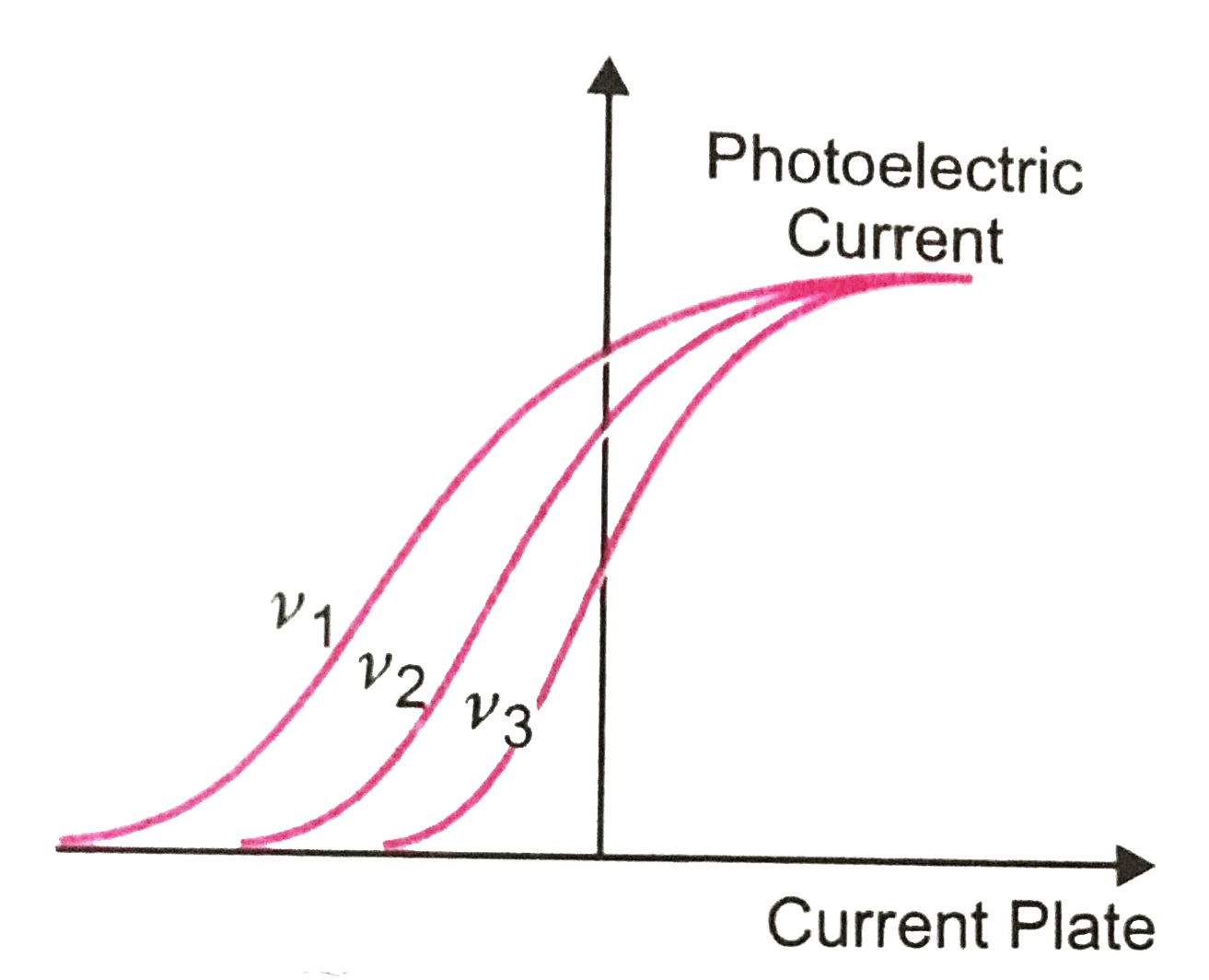
(i) Which physical parameter is kept constant for the three curves?
(ii) Which frequency `(v_1,v_2 or v_3)` is the highest?
View SolutionA source of light is emitting photons. Does all the photons emitted have the same energy? Is the source monochromatic? Explain.
View SolutionA lamp mainly emits light of wavelength `lambda`. The lamp is rated at P watt and 8% of the energy is emitted as visible light.
(i) How many photons of light are emitted by the lamp per second?
(ii) How many photons are falling per second on a square whose length of each side is a, held perpendicular to the incident photons at a distance r from the lamp.
View SolutionX-rays of wavelength `lambda` fall on photosenstive surface, emitting electrons. Assuming that the work function of the surface can be neglected, prove that the de-broglie wavelength of electrons emitted will be `sqrt((hlambda)/(2mc))`.
View SolutionIf an em wave of wavelength `lambda` is incident on a photosenstive surface of negligible work function. If the photoelectrons emitted from this surface have the de-Broglie wavelength `lambda_1`, prove that
`lambda=((2mc)/h)lambda_1^2`
View SolutionX-ray fall on a photosenstive surface to cause photoelectric emission. Assuming that the work function of the surface can be neglected, find the relation between the de -Broglie wavelength `(lambda)` of the electrons emitted to the energy `(E_v)` of the incident photons. Draw the nature of the graph for `lambda` as a function of `E_v`.
View SolutionAn electron and a photon have the same de Broglie wavelength. Which one of these has higher kinetic energy?
View SolutionA proton and an electron have same d-Broglie wavelength which of them moves fast and which possess more K.E. Justify your answer.
View SolutionShow that d-Broglie hypothesis of matter wave supports the Bohr's concept of stationary orbit.
View SolutionIn the nth orbit of hydrogen atom, find the ratio of the radius of the electron orbit and de-Broglie wavelength associated with it.
View SolutionIf the intensity of the incident light (whose frequency is greater than threshold frequency) is increased then explain its effect on (i) the maximum momentum that photoelectron could have and (ii) the minimum de -Broglie wavelength that photoelectron could have.
View Solution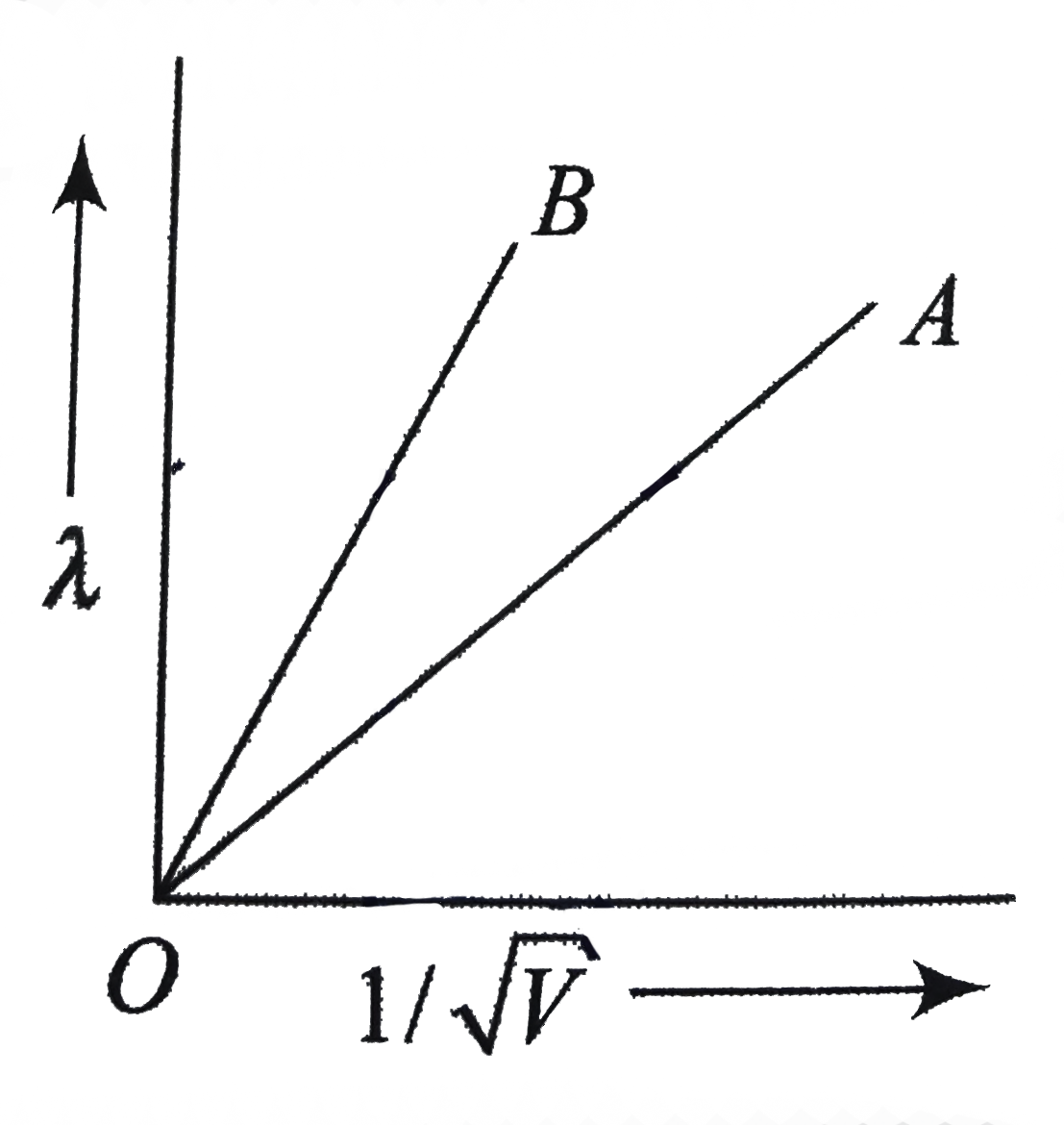
The two lines A and B in fig. show the photo electron of de Broglie wavelength `(lamda)` as a function of `(1)/(sqrtV) `(V is the accelerating potential) for two particles having the same charge. Which of the two represents the particle of heavier mass?
View SolutionThe graph of Fig. shows the variation of photoelectric current (I) versus applied voltage (V) for the two different photosensitive materials for two different intensities of the incident radiation. Identify the pairs of curves that correspond to different materials but same intensity of incident radiation.
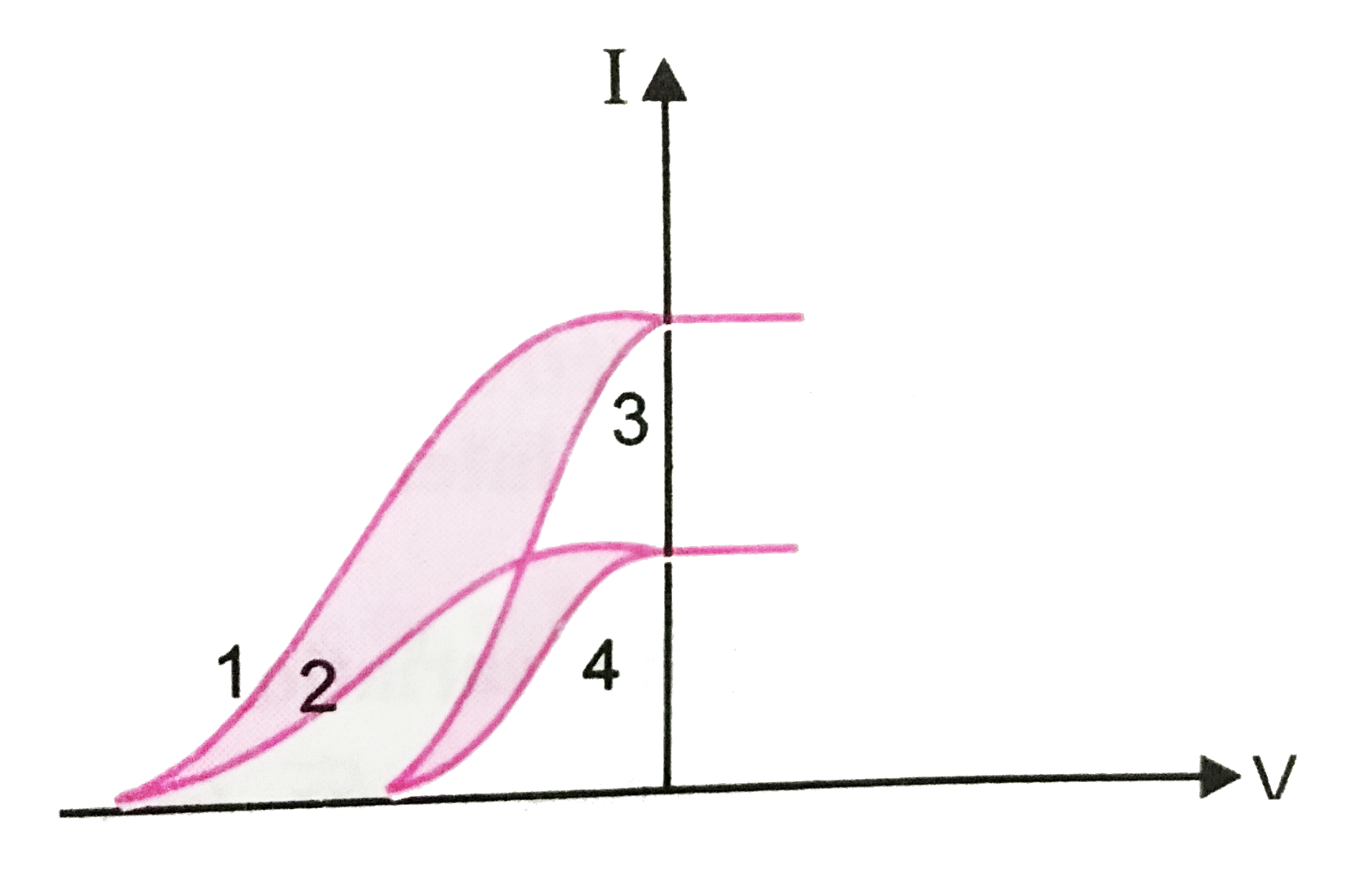
View SolutionThe threshold wavelength for photoelectric emission for a material is `5200 A^(@)`. Will the photoelectrons be emitted when this material is illuminated with monochromatic radiation from 1 watt ultra violet lamp?
View SolutionHow will the photoelectric current change on decreasing the wavelength of incident radiation for a given photo-sensitive material?
View SolutionThe stopping potential in an experiment on a photo electric effect is 1.5 V. What is the maximum kinetic energy of the photoelectrons emitted?
View SolutionThe Fig shows a plot of three curves a, b, c showing the variation of photocurrent versis collector plate potential for the different intensities `I_1, I_2 and I_3` having frequencies `v_1, v_2 and v_3` respectively, incident on a photosensitive surface. Point out the two curves for which the incident radiation have same frequency but different intensities.
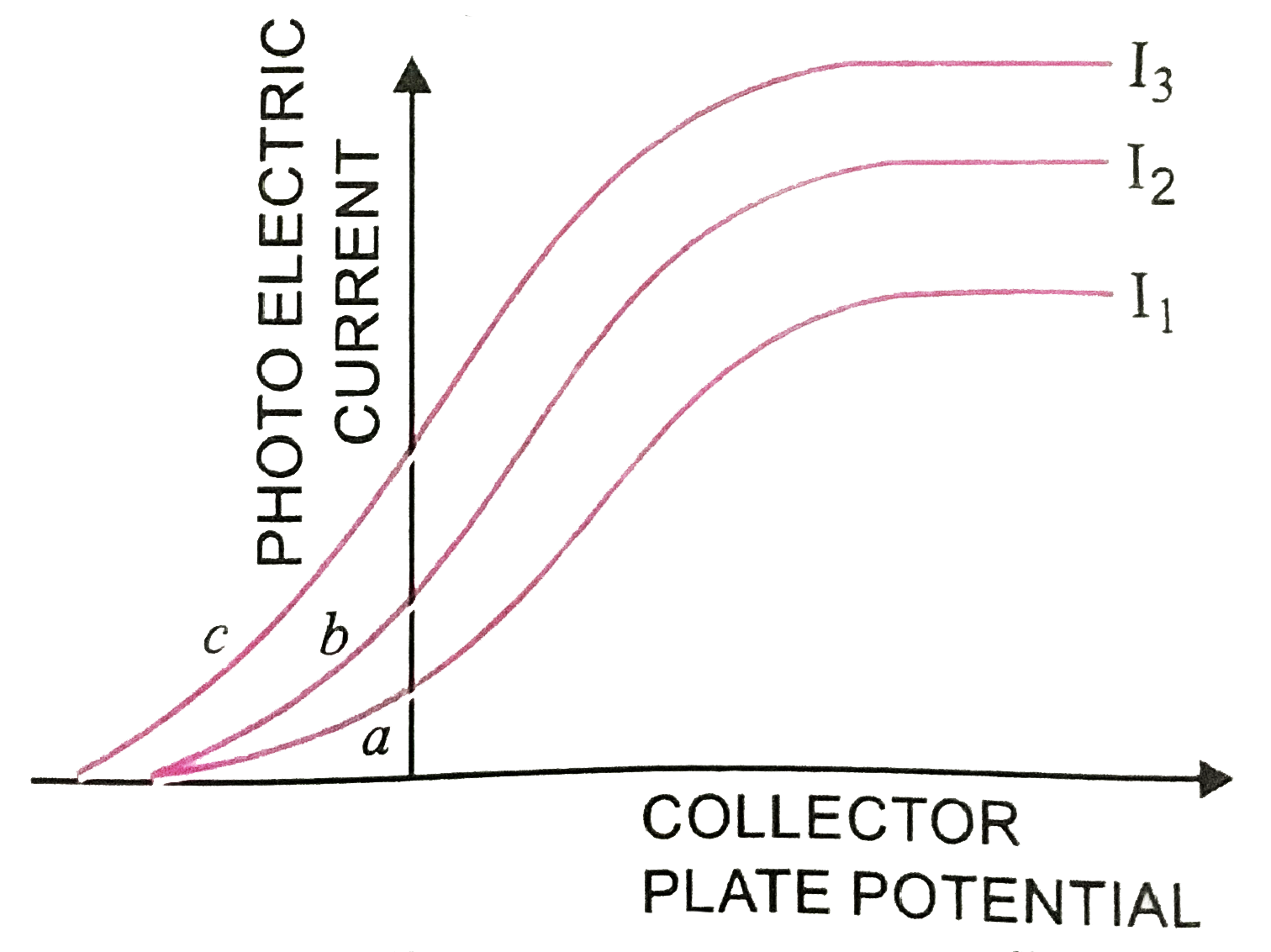
View SolutionWhy are alkali metal surfaces most suited as photo-sensitive surfaces?
View SolutionDoes each incident photon essentially ejcted photoelectron?
View SolutionA source of light is placed at a distance of 1m. From a photocell and the cut off potential is found to be `V_0.` If the distance is doubled what will be the cut off potential?
View SolutionDefine photoelectric work function. How is it related to thresold frequency?
View SolutionThe work function of cesium is 2eV. Explain this statement.
View SolutionThe work function of lithium and copper are 2.3 eV and 4.0 eV respectively. Which of these metals will be useful for the photo-electric cell working with visible light? Explain.
View SolutionIt is harder to remove free electron from copper than from sodium. Which has higher work function?
View SolutionThe work function of copper is 4.0 eV. If two photons, each of energy 2.5 eV strike with some electrons of copper, will the emission be possible?
View SolutionWhat determines the maximum velocity of the photoelectrons?
View SolutionDefine thresold frequency. Is it a constant quantity for a metal surface? Comment. Define space charge. What is its effect on the emission of photoelectrons from a metal surface?
View SolutionDefine space charge. What is its effect on the emission of photoelectrons from a metal surface?
View SolutionIs photoelectric emission possible at all frequencies? Give reason for your answer?
View SolutionOut of microwaves, ultraviolet rays and infra-red rays, which radiations will be most effective for emission of electrons from metallic surface?
View SolutionTwo metals A and B have work functions 4 eV and 10 eV respectively. Which metal has higher threshold wavelength?
View SolutionDoes the stopping potential in photoelectric emission depend upon the intensity of the incident radiation in a photo cell? Comment on it.
View SolutionWhat is the effect of decrease in frequency of incident radiation on the stopping potential in photoelectric emission?
View SolutionWhen the frequency of incident radiation is less than threshold frequency for a metal surface, what is value of stopping potential for that and why?
View SolutionTwo beams one of red light and other of blue light of the same intensity are incident on a metallic surface to emit photoelectrons. Which one of the two beam emits electrons of greater kinetic energy?
View SolutionThe photo electric current at distances `r_1 and r_2` of light source from photoelectric cell are `I_1 and I_2` respectively. Find the value of `I_1//I_2`.
View SolutionLight of frequency .25 `v_0` is incident on a metal surface of threshold frequency 2`v_0`. If its frequency is halved and intensity is made three times then find the new value of photoelectric current.
View SolutionHow does the maximum kinetic energy of electrons emitted very with work uniform of the metal?
View SolutionThe frequency (v) of the incident radiation is greater than threshold frequency `v_0` in photocell. How will the stopping potential very if frequency v is increased, keeping other factors constant.
View SolutionIf the intensity of the incident radiation in a photocell is increased, how does the stopping potential very?
View SolutionPlot a graph showing the variation of photoelectric current with anode potential for two light beam of same wavelength but different intensity.
View SolutionIn an experiment on photoelectic effect, the graph as shown in fig. were obtained between the photoelectric current (I) and the anode potential (V). Name the characterstic of the incident radiation that was kept constant in this experiment.
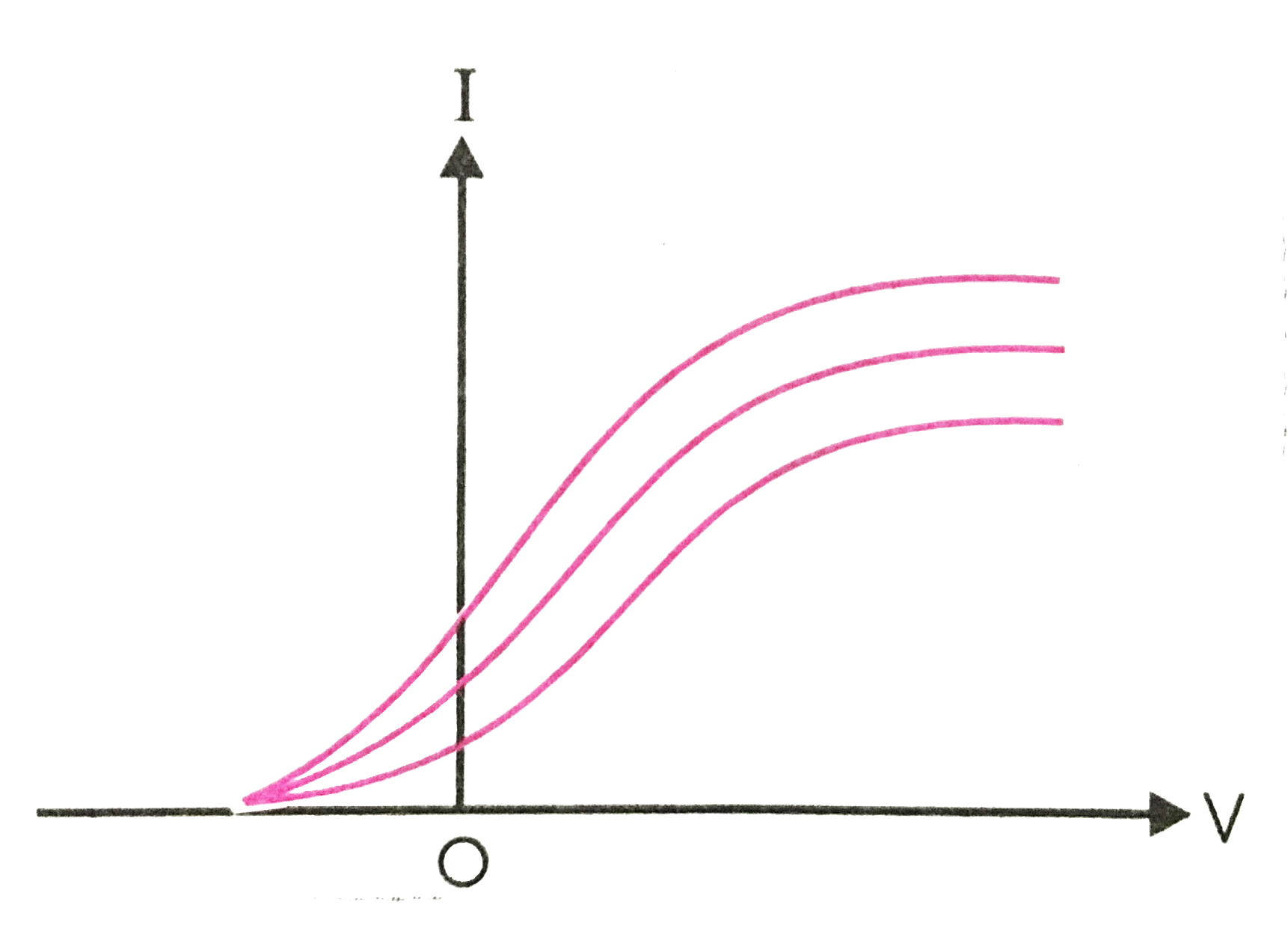
View SolutionDraw a plot showing the variation of photoelectric current versus the intensity of incident radiation on a given photosenstive surface.
View SolutionName the phenomenon which shows the quantum nature of electromagnetic radiation.
View SolutionHow does one explain the emission of electrons from a photosenstive surface with the help of Einstein's equation?
View Solution
Solved Examples questions and complete solutions for chapter DUAL NATURE OF RADIATION AND MATTER of PRADEEP PHYSICS (HINGLISH) of Class 12